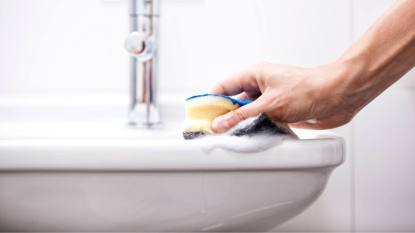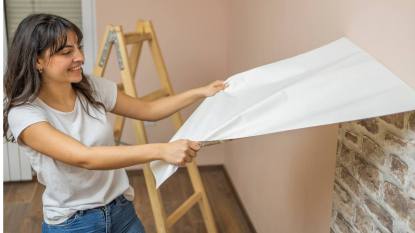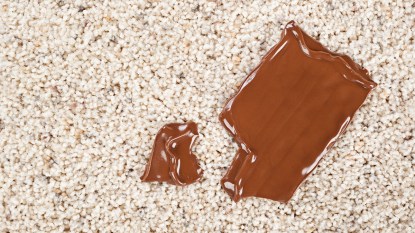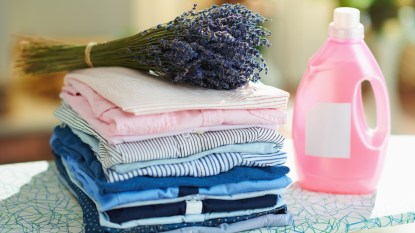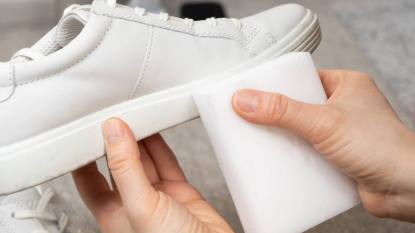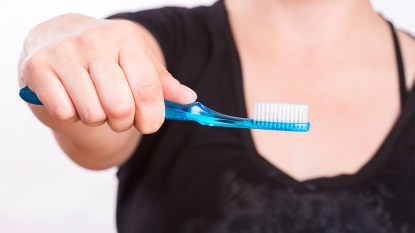Ironware Expert: Despite What You’ve Heard, It’s Fine To Wash Your Cast Iron With Soap
Here's why + everything you need to know about caring for your cast iron pan
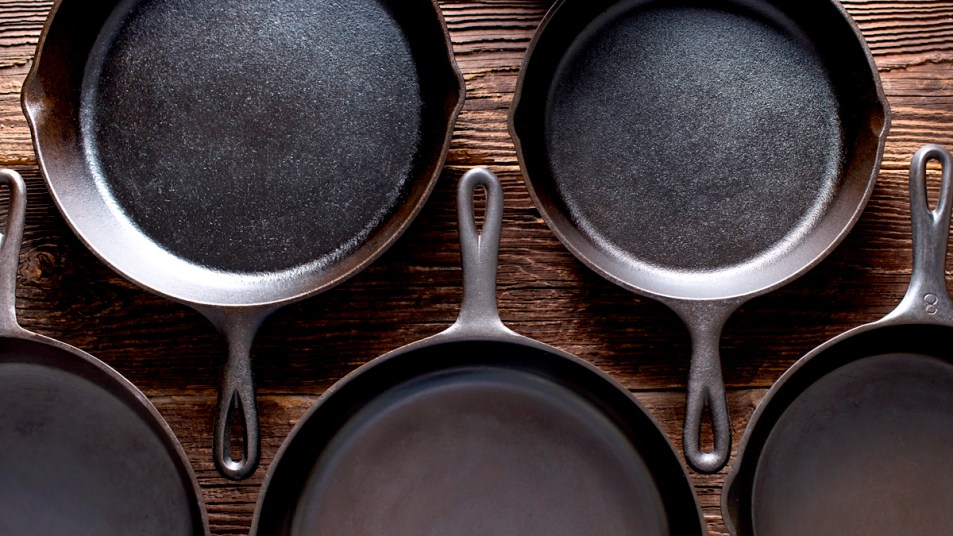
Attempting to find the definitive answer on how to clean cast iron pans, skillets and other cast iron cookware is dicey territory. The subject has caused countless kitchen squabbles over the years. In fact, we wouldn’t be surprised to learn the debate over can you use soap on your cast iron is what actually sparked the legendary feud between the Hatfields and McCoys way back in the day.
The divide boils down to those who believe cleaning cast iron with a little soap won’t do any harm, and those who react as if you’re threatening a beloved family member at the mere idea of any suds touching their perfectly seasoned skillet. Although one side might feel a bit more dramatic, they’re both understandable.
Most people who are strongly against using soap on cast iron products had the lesson passed down to them from a parent or grandparent. There was a good reason for that, according to Ashley L. Jones, author of Modern Cast Iron: The Complete Guide to Selecting, Seasoning, Cooking, and More.
“Our grandmothers told us to never, ever use soap or it would remove the pan’s seasoning,” Jones tells FIRST. “They were right, because the soap used back then contained lye, which will strip a cast iron pan down to the silver.”
Lye is an alkaline metal traditionally derived from wood ash. In its natural form it’s extremely corrosive, so cleaning a cast iron pan with it would strip away all the seasoning — i.e., the protective layer of carbonized oil that prevents rust and keeps food from sticking to the pan.
Is lye safe to use on cast iron?
Part of the reason for the confusion over the soap vs. never-soap debate, stems from the fact that you often hear that soap today “does not contain lye,” making it safe to clean cast iron with — but that’s not a full answer. Lye is still used in the soap-making process today — even by major manufacturers — just like it has been for thousands of years. That’s because it is an essential part of the soap-making process; when mixed with fats, it goes through a process called saponification and the end result is soap.
So, it’s not that soap is safe today because we took lye out of the equation — it’s that when soap is made correctly, the lye is completely neutralized by the saponification process.
The difference today is that we now regulate the soap industry — in decades past, less stringent monitoring of products meant there were soaps on the market that didn’t fully neutralize the lye. In those days, using even a small amount of soap to clean your cast iron could risk damaging it, which is where the “never use soap!” camp of advice began.
There are some important factors to bear in mind, though.
Which soap is safest to use on cast iron?
Unless you’re making your own soap at home and playing fast and loose with the rules, or you’re buying it via a wormhole to the early 20th century, whichever brand you’re using is perfectly safe to use on your cast iron.
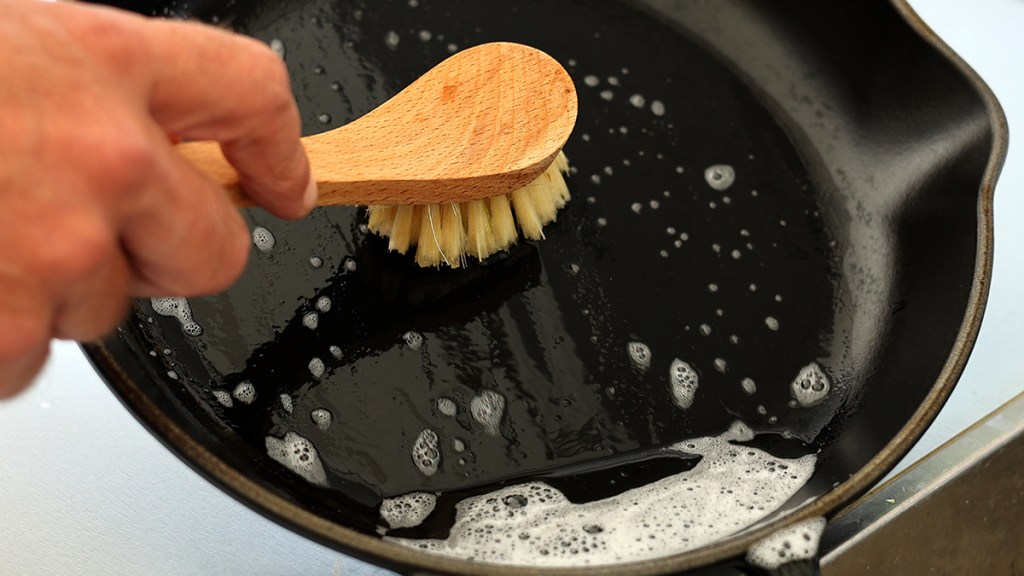
You may have seen chatter online that soap like Dawn isn’t safe—it cleans oil off ducks, surely it will strip your cast iron pan! — but this is simply not true.
Here is how Sydney Cooper from Smithey Ironware Company recommends cleaning a cast iron pan with soap:
- Scrape large food bits out of the pan into the trash or your compost pile— you can use a plastic or wooden spatula for this, or grab the Lodge polycarbonate Pan Scraper (Buy from Lodge, $4.95) and Scrub Brush (Buy from Lodge, $7.90) to get the job done, or try OXO’s version (Buy from Amazon,$11.99) .
- Place the pan in your sink and apply about a teaspoon of dish soap — any store-bought brand is fine, and you don’t need to use a lot.
- Using warm water and a sponge, gently scrub the pan clean and rinse thoroughly, making sure no soap residue remains.
- Once cleaned, place the rinsed pan back on your stove and set the burner to medium heat. Warm the pan until it is completely dry, usually a minute or two.
- Turn off the heat and add about 1 tsp. of a neutral-tasting oil, “we use grapeseed, but vegetable oil is also fine,” Cooper adds. You can also use specially-made cast iron seasoning oil, such as Field Cast Iron Seasoning Oil, (Buy from Field Company, $16) or Caron & Doucet Cast Iron Seasoning & Cleaning Oil (Buy from Amazon, $24.99) — to the pan, and rub it into the surface using a clean, dry dishrag. This helps maintain the pan’s seasoning while it’s in storage.
- Let the pan cool completely and put away. Voila! You’ve cleaned your cast-iron using soap, and no pans were harmed in the process.
How did people used to wash cast iron?
Back in the day when soap wasn’t a reliable method, salt was the go-to agent for getting a cast iron pan clean, thanks to its gentle abrasiveness. And, yes, you can still use salt today to clean cast iron.
How to wash a cast iron pan with salt
The folks at Field Cast Iron Cookware Company—who promise “a little soap now and then is fine”—suggest this method for using salt to clean your cast iron.
- Scrape out any large food particles, like in the soap method above.
- Pour 2 to 3 Tbs. of coarse kosher salt into the skillet.
- Wipe the inside of the pan with a clean rag or paper towel, using the grit of the salt to dislodge any stuck-on food bits and absorb excess oils.
- Rinse completely, then follow the directions above to dry and re-season your pan.
How do you fully re-season cast iron?
While the quick re-seasoning methods above are good for day-to-day use, typically you’ll need to fully re-season your pan about once or twice a year. The easiest way to tell it’s time is if your pan starts looking dull. If that’s the case, just follow these easy steps from Lodge:
- Make sure the pan is completely clean by scrubbing it with soap and water and letting dry completely.
- Spray the pan all over with a thin layer of cooking oil.
- Place the pan in the oven upside down with a baking sheet underneath. Bake at 450-500 degrees F for an hour, then allow to cool.
- Repeat if the pan doesn’t have its signature shiny black coating back.
Can you repair a rusty cast iron pan?
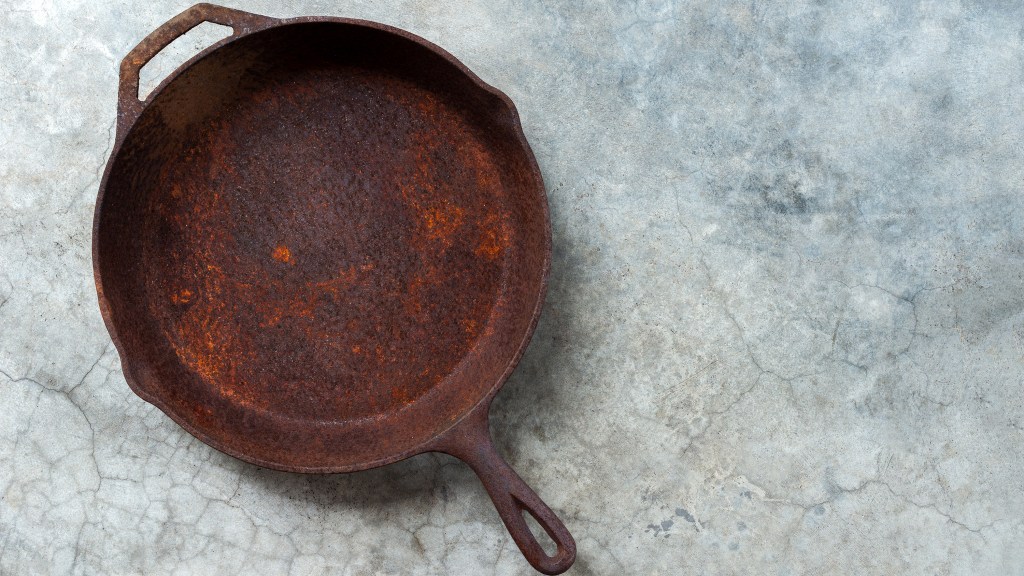
Even if you baby your cast iron, a little rust is normal now and then — and typically all you need to do is scrub the offending spot, then follow the quick re-seasoning process above. But if you’re attempting to restore a badly rusted pan, you can follow these steps from Southern Cast Iron.
- Completely immerse the pan in a solution of one part vinegar and one part water; let soak at least 30 minutes.
- After a half hour is up, begin to gently scrub the pan with a clean scrub brush. If the rust lifts off easily, it’s good to move on to the next step. If it’s still stubbornly sticking to the pan, give it another 30 minutes.
- Once the rust is lifting off the pan, give it a thorough scrub until you’ve removed it completely, then rinse thoroughly.
- Follow the steps above for drying and fully re-seasoning your pan.
One thing all experts agree on?
“For the love of god, don’t put it in the dishwasher!” says Peter Huntley, founder of Stargazer Cast Iron Company. Doing so will cause the pan to rust and remove all that hard-won seasoning.
For more cookware cleaning tips click the links below:
Culinary Pro: The Best Way to Season a Cast Iron Skillet + The Mistake Most People Make
This Easy Hack Will Clean the Stained Underside of a Burnt Pot With Zero Scrubbing






